The Small, Pebble-Bed Modular Reactor Is Indispensable
by Richard Burden and David CherryMay 9—Abundant, low-cost electricity will be the life-blood of the productive and happy Africa of tomorrow. The existing, small but growing flow of electricity is the “river” that will bring Africa to its tomorrow, and nuclear power will be indispensable to the rapid growth of this flow. It is also true everywhere in the world. Africans are increasingly realizing this, from South Africa and Zambia to Egypt and Algeria; from Ghana, Nigeria, and Niger to Kenya, Uganda, and others.
Technological apartheid has largely kept nuclear science and engineering out of Africa with the help of anti-nuclear propaganda. But now, Africa is becoming aware that nuclear power is the cheapest source of electricity, and very safe.1 To tap into nuclear, Africa is developing the scientific, engineering, and technical cadre for the construction and management of nuclear power plants.
Why Small ‘Modular’ Reactors?
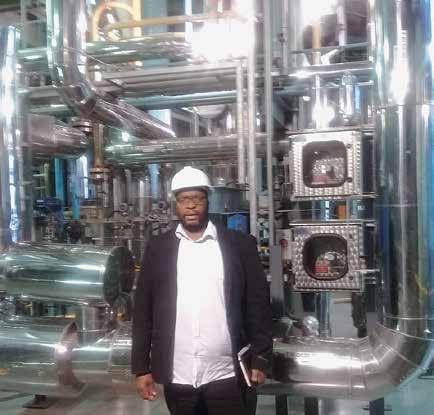
A large power plant, with its economy of scale, is best for large urban areas or for a country that has a well-developed power grid, as well as a transportation network allowing the grid to be serviced easily. These enable the power plant to efficiently deliver its electricity to millions of users. But what if there are smaller, scattered populations in regions that have no grid or roads, or very poor ones— a common occurrence in Africa? That’s where smaller plants are better, instead of running long transmission lines through undeveloped land.
As such a region increasingly develops, it may be more economical to keep placing more small reactors
of the same or very similar size and design in the same power station, than to establish new sites for entirely new power stations, or to place a much larger reactor of different design in the same site.
Such small reactors are called small “modular” reactors (SMRs) because they share infrastructure and personnel with a number of identical or nearly identical reactors at the same power station, and their parts and operational protocols are all very similar and interchangeable. Their smaller size means that more copies
can be produced with the same investment in the reactor manufacturing plant, leading to more rapid accumulation of experience in all phases of the reactor life cycle, and the reactor cores (containing the fuel) can be shipped easily in one or two pieces to places where barges and extra-wide trucks, needed for large reactors, cannot go.
Having multiple reactors in the same station also improves redundancy, allowing one reactor to be shut down for maintenance without starving the grid. With smaller reactors, the decision to add one more is less momentous, making it easier to match power supply to demand, and also easier to finance power production, so long as the loss of economy of scale in the smaller reactor is not too great. There are now more than 80 designs for these SMRs being developed, primarily in the United States, Canada, the UK, China, and Russia. In 2020 the International Atomic Energy Agency (IAEA) published an update of its SMR book, Advances in Small Modular Reactor Technology Developments, with contributions from developers covering more than 70 designs. But one design in particular was developed with the needs of developing countries in mind—the South African HTMR-100. This finished design is offered by the private company Stratek Global, whose founder and CEO is the nuclear physicist and engineer, Dr. Kelvin Kemm. Stratek Global brings experts with three decades of experience in the design and R&D leading to this result. The HTMR-100 design is covered in the IAEA’s SMR book, pp. 171–174. (At the time of publication, the corporate name of the designers was STL Nuclear (Pty.) Ltd.) Here is a sketch of the history.
The Pebble-Bed Modular Reactor
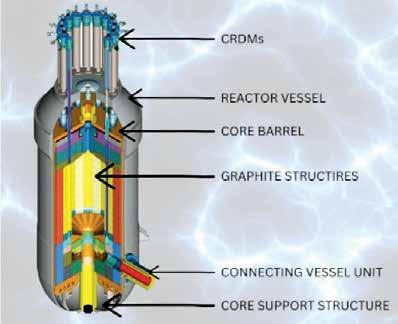
The interior of the HTMR-100 small modular reactor vessel. Nuclear fission heats helium gas, which circulates to an adjoining vessel where it boils water to generate steam. The steam drives a turbine to generate electricity. (At the top, the CRDMs are the Control Rod Drive Mechanisms.)
These pebbles are fed into a pipe at the top of the reactor; they are held in the reactor until sufficiently spent, when they are fed out at the bottom as new ones are added from the top. It is never necessary to shut down the reactor to refuel it (see Figure 1).
The forerunner design of the HTMR-100 was the Pebble-Bed Modular Reactor (PBMR®-400),2 a design for a gas-cooled thermal (slow) neutron spectrum nonbreeder reactor developed in South Africa. It is based on the AVR reactor, which came online in 1967 from Germany’s high-temperature reactor (HTR) development program at Jülich, and operated successfully for 22 years.3 “Pebble bed” refers to the fuel, which comes in the form of billiard ball-sized spheres (the pebbles) of smooth and shiny graphite. Inside each sphere are many poppy seed-sized, specially coated, spherical grains of nuclear fission fuel.
Conquering the Desert: Rivers of Water or Rivers of Blood
South African scientists had become interested in the pebble-bed concept when one of them, Johan Slabber of South Africa’s Atomic Energy Board—precursor of the state-owned South African Nuclear Energy Corporation (NECSA) of today—visited Germany in 1988. He and two others formed PBMR (Pty.) Ltd in 1993. EIR recalled this background in 2006 (“South Africa’s PBMR: World’s Most Versatile Nuclear System ”), in reporting that when Germany terminated its HTR program in 1990—foreshadowing the shutdown of that nation’s entire, once-proud nuclear sector— South Africa, China, and Japan continued it.
The inventor of the high-temperature reactor, Prof. Rudolf Schulten, died in 1995, just two weeks after having signed a crucial agreement with South Africa for the transfer of the HTR technology.4
South Africa’s state-owned power company, Eskom, after completing a detailed feasibility study in 2002, made an initial commitment to install PBMRs constituting a minimum of 1,100 MWe (megawatts electric), beginning with a “Strategic National Demonstration Project” that was to begin construction in 2007
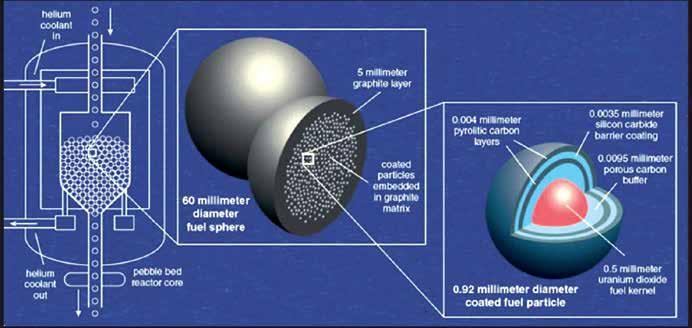
TRISO fuel consists of tiny, spherical kernels of uranium dioxide (diameter 0.5 mm), each with coatings as shown on the right, to make fuel particles that are embedded in a 60 mm diameter pebble of graphite. The particle coatings securely contain the fission products. The pebbles are fed into the top of the reactor. When the uranium is sufficiently spent, it is let out at the bottom as new pebbles are added at the top. The reactor never needs to be shut down for refuelling.
and be completed by 2011. Beyond that, Eskom was looking at adding more than 4,000 MWe as PBMRs, and several more reactors of the Koeberg (South Africa) water-cooled type.
Such life-giving work did not escape the notice of misanthropist George Soros and his Open Society Foundation (OSF). They had already swung into action, beginning no later than 1999, to stop the PBMR concept. They backed a 1999 report by the British anti-nuclear “expert” Steve Thomas, which purported to show that the PBMR was not safe. Thomas drew on German whistleblower Rainer Moormann’s erroneous interpretations of AVR data. Moormann’s and Thomas’s claims did not stand up to scientific criticism,5 but were widely circulated as if they were sound. For years, Thomas wrote against the PBMR. His work was fed into South Africa through Earthlife Africa and was influential in some government circles and trade-unions. Soros funded court action by Earthlife Africa against the PBMR.6
China, for its part, announced in 2005 its intention to scale up its HTR-10 experimental reactor for commercial power generation. The first two 250 MWt (megawatts thermal) HTR-PMs (High-Temperature GasCooled Reactor Pebble-bed Modules) were planned for
installation at Shidao Bay near the tip of the Shandong Peninsula, and together would drive a steam turbine generating 210 MWe. Construction began in December 2012. (More about the HTR-PM below.)
The PBMR®-400 design used a gas turbine, circulating the same gas (helium) through both the core and the turbine, with the gas leaving the core at up to 940°C, and an electricity generating capacity of 165 MWe.
At the high-temperature reactor (HTR) conference in Washington, D.C. in 2008, the South Africans and the Chinese saw the need to cooperate to benefit from their synergies. As a result, a memorandum of understanding to facilitate cooperation was signed in Beijing on March 26, 2009, between PBMR (Pty.) Ltd and, on the Chinese side, the Institute of Nuclear and New Energy Technology (INET) of Tsinghua University and Chinergy Co Ltd.
But in February 2010, “lightning” struck the South African side: The government suspended all funding for the PBMR. The worldwide financial crisis of 2008 had had unpleasant consequences; there was a change of government in Pretoria; and the Soros-funded scare propaganda was taking its toll. The project was mothballed and most of the 2,000 workers—many with special skills and years of experience on the project—were let go.7
Beginning in 2016, there was a government project to further develop the PBMR design as the Advanced High-Temperature Reactor 100 (AHTR-100) under the auspices of Eskom Holdings SOC. But in 2019, this R&D work was suspended for want of funding.
Yet, that was not the end. In 2012, some of the PBMR team had taken up the PBMR concept for a privately owned project under the corporate name, Steen-
relatively low temperature of 750°C to circulate through the steam generator directly—without an intermediating loop—to drive a standard steam turbine. (The HTMR100 design has the advantage that all components downstream from the reactor itself are commercially available off the shelf.)
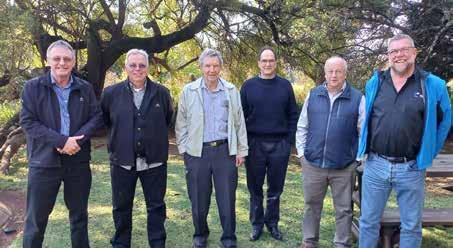
The PBMR and HTMR-100 were designed to eliminate corrosion, the possibility of a meltdown, the possibility of any kind of explosion or fire, any need for backup generation to maintain coolant flow, and any radioactivity of the primary coolant. Only massive sabotage, including destruction of the passive heat removal system, could lead to any significant leak of radioactive material, and even then, it would be small compared to what has happened in water-cooled reactors suffering meltdowns. With this level of passive safety, the plant can be operated with knowledgeable, well-trained personnel who are not necessarily experts.
kampskraal Thorium (Pty.) Ltd, or for short, STL Nuclear. Their design, the HTMR-100, was completed in 2022. Today STL Nuclear is integrated into Dr. Kemm’s Stratek Global.
Meanwhile, the government has become interested. On May 29, 2019, anti-nuclear Minister of Energy Jeff Radebe lost his portfolio to the pro-nuclear Gwede Mantashe, under whose leadership the national Integrated Resource Plan was revised to include 2,500 MWe of new nuclear power. In early May 2020, Mantashe informed Parliament that his department was working on a roadmap for acquisition of the 2,500 MWe of new nuclear power, and that all options were being explored, including small modular reactors. On June 14, 2020 his department issued its request for information (RFI) to potential vendors.
The Inherently Safe HTMR-100
Four components are key to this safety: (1) Extremely heat-tolerant TRISO fuel; (2) helium as the primary coolant; (3) very low excess reactivity8 at fuel loading, allowing thermal expansion of the fuel to stop any runaway reaction without control rods; and (4) passive removal of decay heat (the heat generated by the natural radioactive decay of one isotope to another) in a manner that requires no operator intervention and no electric power whatsoever.
Using helium as the primary coolant guarantees that there will be no fire, explosion, or release of radioactive primary coolant, because helium is not only the most chemically inert of all substances, it is also the most resistant to neutron activation (adding a neutron to the nucleus), which can make non-radioactive substances in a nuclear reactor become radioactive.
In 2022, Dr. Kemm founded Stratek Global as a new vehicle for the newly completed design, the HTMR100, which will produce about 100 MWt and 35 MWe. The helium coolant gas will leave the reactor core at a
Conquering the Desert: Rivers of Water or Rivers of Blood
The first component: TRISO fuel (Tri-Structural Isotropic particle fuel), invented for gas-cooled reactors by Prof. Schulten in Germany and first developed in Pretoria as part of the PBMR project, is divided into spheres 0.35-0.40 mm in diameter, surrounded by layers of porous and pyrolytic carbon and silicon carbide
to make a grain 0.8-1.0 mm in diameter. These are bound up with graphite into spherical “pebbles” about the size of a billiard ball. The graphite serves as a neutron moderator (it slows the neutrons down) and reflector, but also conducts heat out to the spaces between the balls, through which compressed helium flows rapidly, carrying heat away efficiently without carrying away the fuel, as it would if the fuel were in smaller pieces.
TRISO fuel has been exhaustively tested in laboratories in the U.S. and elsewhere, to verify its ability to contain fission products, including volatile fission products (boiling point below fuel temperature), at temperatures up to 1,600°C.9 Of course, the fuel balls cannot

Global
Limpopo province, South Africa, has been interested in the HTMR-100 since 2023: (l. to r.) Francois Mellet and Kelvin Kemm of Stratek Global; Thakani Makhuvha, CEO for the Limpopo Economic Development Agency (LEDA); and Lawrence Mabaso, CEO of Lawmab Consulting.
contain unlimited quantities of boiling fission products, so the extent of the fuel burnup (the fraction of fuel atoms that undergo fission) is therefore limited. But the layers of porous carbon and pyrolytic carbon in the balls provide maximum space for the volatile fission products, while still maintaining adequate thermal conductivity. The result is that the fuel can achieve three times higher burnup than standard light water reactor fuel.
The second component: Using helium as the primary coolant guarantees that there will be no fire, explosion, or release of radioactive primary coolant, because helium is not only the most chemically inert of all substances, it is also the most resistant to neutron activation (adding a neutron to the nucleus), which can

Dr. Kemm gave a one-day seminar to 31 generals and colonels at the South African Defence College this year, which included officers from elsewhere in Africa such as Egypt, Tanzania, Uganda, Namibia, and Zambia.
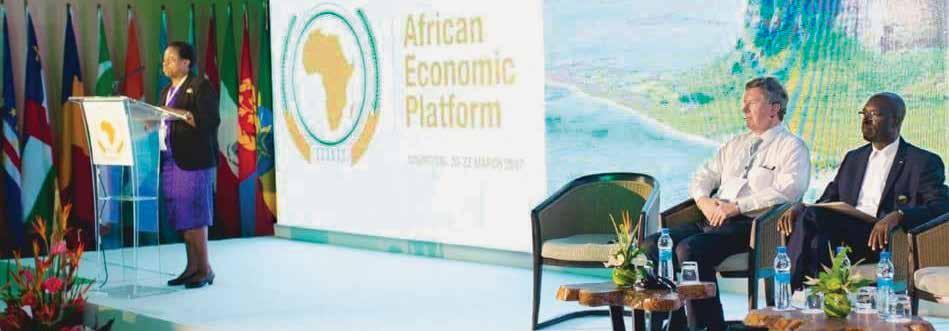
Kelvin Kemm is an evangelist of nuclear power and the global evangelist of the pebble bed small modular reactor. He has given briefings to the U.S. Senate and Congress, and chaired the opening ceremony of ATOMEXPO in Moscow, 2016. He has spoken at tribal events in Venda and Sekhukhuneland (South Africa), and in southern Angola. He was a guest speaker at the African Union Economic Summit in Mauritius, 2017, shown here.
make non-radioactive substances in a nuclear reactor become radioactive. While it clearly is not the most efficient heat transfer medium, due to its low heat capacity per unit of volume and its low thermal conductivity, the heat tolerance of TRISO fuel and the very low density and non-viscosity of helium allows the helium to flow rapidly with minimal pump work and for the heat to be carried away at an adequate rate.
With the primary coolant guaranteed to be non-radioactive, no intermediating heat transfer loop is needed; the helium can go directly into a turbine that is not designed to contain highly radioactive material, which is of course much cheaper.10
The same inertness and non-radioactivity of the primary coolant allows radioactive materials to be easily kept out of it by filtering. The design provides for continuous and thorough filtering of the helium, so that if the core overheats and pressure builds, only pure helium—without any radioactive contaminants—is vented to bring the pressure back to normal.
cause the fuel is automatically added to the top and removed from the bottom—one pebble every few minutes—without stopping the reactor. The HTMR-100 would add and remove 125 to 150 pebbles per day to a fuel assembly containing about 150,000 pebbles.
The fourth component: Passive removal of decay heat after the fission chain reaction is stopped11 is much less costly to achieve with helium-cooled than with water-cooled reactors because the former tolerate much higher primary coolant temperatures. When water overheats even slightly,12 it boils away, drastically reducing
The high output temperature of the primary coolant has economic value as industrial process heat, if an industrial facility that can use the heat can be sited close by. The high output temperature also allows a more efficient conversion of heat to electricity, which more than compensates for the passive heat loss during normal operation.
The only containment building this reactor needs is an adequate defense against external attack, and even that need not be invincible. If the core is torn open, exposing the graphite-encased pebbles and surrounding graphite cylinder to air, the graphite will glow red from its temperature but will not burn, because the graphite, except for the innermost layer in contact with the fuel in each tiny particle, is very non-porous. As the pebbles spread, no longer surrounded by graphite, the fuel will go sub-critical, stopping the fission chain reaction, and become cooler as it is exposed to air.
The third component: The PBMR and HTMR100 were designed so that thermal expansion of the fuel stops the chain reaction without a control rod scram (sudden insertion of control rods to absorb neutrons) in the event that the flow of primary coolant stops or the heat sink is lost. The extremely high temperature tolerance of the fuel, the lack of excess reactivity, and the primary coolant being already a gas and inert, make this a certainty, because a large temperature increase would have to occur before trouble begins, while only a small increase is needed to cause the reactor to go sub-critical, stopping the chain reaction until the fuel cools back to normal operating temperature.
As with other non-breeder reactors, the new fuel that enters this reactor has excess reactivity until some of its initial fissile content is consumed. However, the reactor as a whole need not have excess reactivity, be-
Conquering the Desert: Rivers of Water or Rivers of Blood
the rate of heat removal from the fuel, and when zirconium fuel cladding overheats, it reacts with the water vapor exothermically (releasing heat), producing hydrogen gas, which is flammable and potentially explosive. Matter conducts heat at a rate proportional to the existing temperature gradient, or change in temperature per unit distance within the matter, and radiates heat at a rate proportional to the fourth power of the absolute temperature of the matter. Thus, a reactor operating at 750°C (1023 K) output temperature, such as the HTMR-100, radiates over 8 times more rapidly than a typical pressurized water reactor at 340°C (613 K), while conducting heat 2.3 times more rapidly,13 all other factors being equal.
The HTMR-100 needs no insulation around its metal pressure-vessel wall, which radiates heat into a cavity passively cooled by water-filled vertical tubes inside the cavity and attached to the cavity wall, but at some distance from the pressure vessel. As the water inside the tubes boils, it rises from the cavity to radiators outside the building and above ground, where it condenses, then falls back to the bottom of the tubes in the cavity, which is below ground. The cavity, made of pre-stressed concrete, is a low-pressure region, below ambient air-pressure, which serves to capture leaks of helium coolant until it can be filtered before it escapes outside the building. The cavity limits heat loss by conduction and convection from the pressure vessel,
but allows heat to be radiated across it to the water tubes.
The power density (per unit volume of the active region of the reactor core) is much lower than is seen in water-cooled reactors— about 19 times lower in the PBMR®-400, and lower still in the HTMR-100, because helium is a much poorer heat transfer medium than water. This means a larger core is needed to produce the same amount of power.14 However, the larger core need not be more expensive to build or less durable. The graphite shields the metal core wall from neutron damage and the high temperatures of the active region.
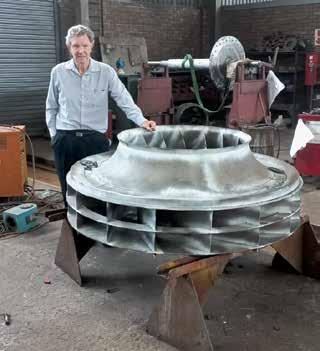
The pressure of the gas in the PBMR is high but still much less than in pressurized water reactors, which operate at around 150 atmospheres, so the core wall does not need to be as strong. And with the primary coolant being gas at all temperatures and pressures that are possible inside the reactor, there is no danger that the pressure will go suddenly much higher due to the boiling of a liquid15 if there is a power surge or a failure of cooling. Consequently, the containment building does not need to be much larger than the core.
The high output temperature of the primary coolant has economic value as industrial process heat, if an industrial facility that can use the heat can be sited close by. The high output temperature also allows a more efficient conversion of heat to electricity, which more than compensates for the passive heat loss during normal operation.
The HTMR-100 Moves Ahead
The HTMR-100 is not in the design phase; that is complete. Research and development is done. Now it must be built.
A “groundbreaking strategic partnership” to raise the funds for construction of the first reactor was announced at a March 19, 2024 press conference in Pretoria, in which representatives of C5 Capital, the South-
ern African Agri Initiative (SAAI), and Dr. Kemm for Stratek Global, participated. The partners stated:
The Southern African Agri Initiative (SAAI) and C5 Capital, a pioneering investment firm based in Washington, D.C., specializing in advanced nuclear energy solutions, announced a groundbreaking strategic partnership today. This alliance aims to spearhead the development of innovative nuclear solutions to bolster agriculture and ensure food security across South Africa and the wider African continent. This initiative not only marks a significant stride towards alternative energy solutions for regions plagued by inconsistent energy production, but also sets the standard for similar projects throughout Africa. The partnership is founded on a mutual commitment to harnessing advanced nuclear technology to revolutionize agricultural practices, conserve natural resources and fortify food security. The collaboration will explore the application of cuttingedge nuclear techniques to enhance agricultural productivity, animal health, food safety and quality, and effective land and water management, among other critical areas.
The partnership is committed to the full spectrum of nuclear technologies, and SAAI specifies that the partnership “is set to revolutionize the agricultural sector through the innovative application of pebble bed nuclear technology.”
Supposed doubts about the viability of the pebblebed design—never of merit—are further weakened as China’s pebble-bed reactor, the HTR-PM, officially began commercial operation on Dec. 6, 2023 at the Shidao Bay Nuclear Power Plant near the tip of the Shandong Peninsula. There, each of two reactors produces 250 MW thermal, and together they drive a single 210
MWe steam turbine, as originally planned in 2012, achieving the same 42% efficiency as South Africa’s PBMR design, but with a steam turbine. South Africa’s pioneering design for a smaller
Footnotes
1. The energy density (energy per unit of mass) of pure fissile material is over 1.6 million times that of natural gas, the second most energydense fuel available on Earth. The full use of all isotopes of uranium, thorium and trans-uranic elements is the domain of breeder reactors. See Richard Burden, “The Fast Neutron Breeder Can Be a Truly CostCutting Nuclear Power Plant.”
Even with poor use of uranium, non-breeder reactors, which are nearly all nuclear reactors presently or ever in use, still have a huge advantage over coal and other hydrocarbons in fuel cost, the size of the fuel and waste streams, and in the ability to store enough fuel at the plant to last decades safely and economically. The advantage does not disappear even when we consider that most uranium ore is less than 1% uranium by mass, because only the uranium needs to be transported, made into fuel and stored. This, and uranium’s chemical properties, also makes less disruptive methods of mining feasible, such as in-situ leaching and filtration from seawater.
Coal and hydrocarbons, in turn, have obvious advantages over “green” and “renewable” energy. The use of the former is mandated by the low labor requirement per unit of energy, whereas the use of all kinds of the latter is mandated by environmentalist dogmas invented for the purpose of social control, as is extensively documented in EIR
2. Also covered in the IAEA’s SMR book, pp. 163–166, with a timeline of its development milestones on p. 166.
3. Jonathan Tennenbaum, “South Africa’s PBMR: World’s Most Versatile Nuclear System,” EIR, Feb. 10, 2006, p. 36.
See also the introduction, p. 55, in S. Ion et al., “Pebble Bed Modular Reactor—The First Generation IV Reactor To Be Constructed,” Nuclear Energy, 2004, Vol. 43, No. 1, February, pp. 55–62.
4. A good overview of the AVR experience, and a rebuttal of those who call the PBMR unsafe based on that experience, is Gregory Murphy’s “Who Is Trying To Strangle the Pebble-Bed Reactor?” in EIR, Dec. 12, 2008, in which he reports on the relevant discussion at the 2008 meeting of the American Society of Mechanical Engineers.
5. See Tennenbaum, p. 39 (footnote 3 above).
6. EIR reported the attacks on the PBMR in detail in three articles: “Who’s Sabotaging the PBMR?” by Dean Andromidas, April 28, 2006; “The Nuclear Power Revolution: Modular High-Temperature Reactors Can Change the World,” by Marjorie Mazel Hecht, November 21, 2008; and the article by Gregory Murphy, Dec. 12, 2008, see note 4.
7. See “History” in Stratek Global’s brochure
8. Excess reactivity is a reactor condition in which the fission chain reaction produces more than enough free neutrons to sustain the chain reaction. Fresh fuel loaded into a non-breeder reactor must have sufficient fissile content to support excess reactivity, otherwise the chain reaction will stop as soon as it starts as a result of consumption of the fissile material. If excess reactivity is unchecked by control rods or neutron-absorbing “poisons” such as boron, the free neutron population will grow, causing the rate of fission to rise exponentially until thermal expansion of the fuel (which increases free neutron leakage) or consumption of fissile material stops the growth of the free neutron population. Standard practice is to slowly pull out the control rods as the fuel ages, and/or use “burnable poisons” that absorb more neutrons while the fuel is fresh and less later.
SMR, the HTMR-100, will make a major contribution to electrifying Africa—and the world. According to Dr. Kemm, South Africa could be exporting the HTMR100 within five years.
9. Paul Demkowicz, TRISO Fuel: Design, Manufacturing and Performance Advanced Reactor Technologies, Idaho National Laboratory, Training Course Module at Nuclear Regulatory Commission High Temperature Gas Reactor (HTGR) Training, July 16–17, 2019. See also a very brief, earlier report from the U.S. Department of Energy’s Office of Nuclear Energy, November 2009: “Advanced Gas Reactor Fuel Program’s TRISO Particle Fuel Sets a New World Record for Irradiation Performance.”
10. Water is only marginally subject to neutron activation, but even under normal operating conditions it will also contain small amounts of dissolved or corroded materials from the core which are more significantly neutron-activated. Under normal operating conditions, helium flowing through a reactor with fuel encased in balls of graphite will contain some neutron-activated graphite dust—from the fuel pieces rubbing against each other as they very slowly move through the core—and traces of leaked fission products. But these will be easier to filter because helium is utterly incapable of dissolving or corroding or chemically bonding with anything. The PBMR and HTMR designs provide for filtration of graphite dust and other impurities in the helium.
11. Decay heat is produced not by nuclear fission but by spontaneous decay of radioactive isotopes. Decay heat increases as fuel becomes more used because the inventory of long-lived but still radioactive fission products and products of neutron activation increases. Decay heat reaches about 11% of the heat generated in most reactors before the fuel is removed, reaching most of that figure early, as very shortlived isotopes produce most of the heat. When a fission chain reaction is stopped, decay heat continues to be up to 7% of the reactor’s designed capacity, but drops as the most short-lived—and therefore most radioactive—isotopes change into longer-lived or stable isotopes. After an hour or slightly longer, the decay heat is typically down to just 1% of design capacity of the reactor, but the decay heat declines much more slowly afterward, as longer-lived isotopes become the dominant source of heat. Thus it is strategically important to have some way of removing this heat in the event that the normal system of heat transfer fails, because just stopping the fission by inserting neutron-absorbing control rods will not stop the production of decay heat.
12. Water-cooled reactors use extremely high pressure in order to keep water liquid or sufficiently dense at temperatures high enough for efficient generation of electricity. To achieve a boiling point of just 350°C, 163 atmospheres of pressure are required; at 300°C, only 86 atmospheres; at 250°C, just 40 atmospheres, so a small rise in temperature greatly increases the pressure requirement. Helium pressure increases much less rapidly, in first-power proportion to absolute temperature, in accordance with the ideal gas law.
13. Assuming an ambient temperature of 27°C (300 K).
14. The active region of the PBMR was designed to generate 4.8 MW thermal per cubic meter. See S. Ion, et al., p. 57 (footnote 3, above). According to the IAEA, pressurized water reactors have the second highest power density among types of reactors presently in use, with an average of about 90 MW thermal per cubic meter (or 90 kW per liter).
15. See footnote 12.
